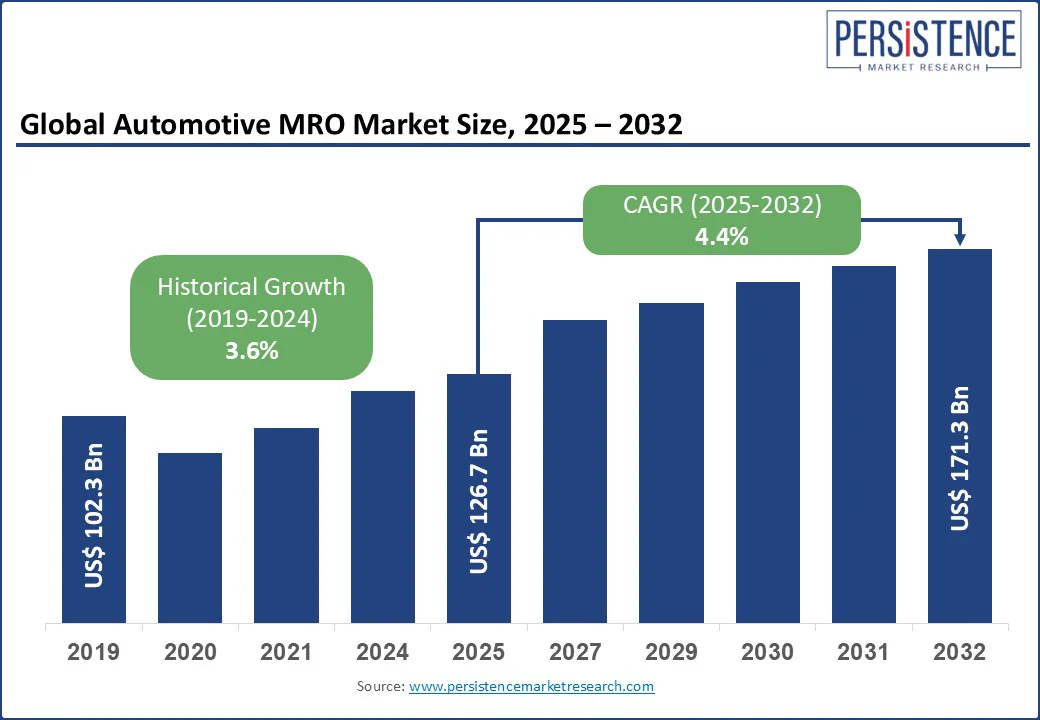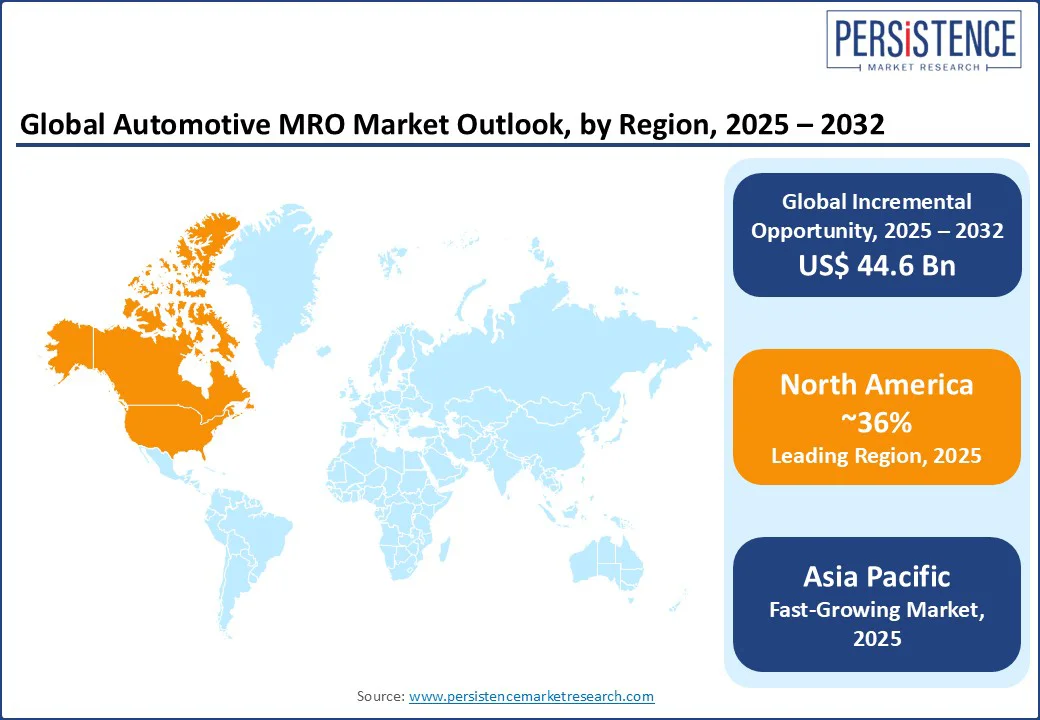ID: PMRREP32669| 209 Pages | 18 Aug 2025 | Format: PDF, Excel, PPT* | Automotive & Transportation

The global Automotive MRO Market size is likely to value at US$126.7 Bn in 2025 and is expected to reach US$171.3 Bn by 2032, registering a CAGR of 4.4% during the forecast period 2025 - 2032.
The Automotive MRO industry is steadily expanding, fueled by a rising global vehicle fleet, increasing average vehicle age, and heightened demand for advanced diagnostic tools and preventive maintenance services. These factors, combined with technological advancements, are driving consistent growth across both passenger and commercial vehicle segments.

Key Industry Highlights:
|
Global Market Attribute |
Key Insights |
|
Automotive MRO Market Size (2025E) |
US$126.7 Bn |
|
Market Value Forecast (2032F) |
US$171.3 Bn |
|
Projected Growth (CAGR 2025 to 2032) |
4.4% |
|
Historical Market Growth (CAGR 2019 to 2024) |
3.6% |
The global increase in vehicle ownership and aging fleets is a key driver of the automotive MRO market. Passenger cars and light commercial vehicles remain the leading segments, with the rising incidence of vehicle breakdowns, particularly among older fleets, driving demand for maintenance and repair services. In the U.S., the average vehicle age has risen significantly, necessitating advanced MRO procedures. The growing number of maintenance procedures performed in recent years has further increased the need for sophisticated MRO tools and parts.
Technological advancements in vehicle design and diagnostics are also propelling market growth. Modern systems, such as Bosch’s diagnostic scanners, offer improved accuracy and reduced repair times, enhancing vehicle outcomes. A study reported that automated diagnostic systems reduce repair complications compared to manual methods. The integration of real-time monitoring and compact designs further supports adoption in predictive maintenance services.
Government automotive initiatives and increased funding for infrastructure also drive market expansion. In India, national mobility schemes such as the FAME (Faster Adoption and Manufacturing of Electric Vehicles) initiative have expanded access to vehicle repairs, increasing demand for MRO services. In North America, favorable policies for fleet maintenance incentivize garages to invest in advanced equipment, further boosting market growth.
High costs of automotive MRO tools and parts continue to hinder widespread adoption, particularly in emerging markets. Advanced tools, often equipped with features such as digital diagnostics and IoT connectivity, require a substantial upfront investment. Beyond the initial purchase, ongoing maintenance expenses, consumables such as lubricants and oils, and technician training add to the total cost of ownership. For garages in resource-limited regions, such as parts of Latin America and rural India, these financial constraints make it challenging to invest in advanced equipment, even with rising demand for vehicle repairs. This limits access to efficient maintenance and highlights the need for affordable, scalable solutions.
The shortage of skilled personnel to operate and maintain complex MRO equipment further slows market growth. Using advanced diagnostic systems demands specialized training for technicians, yet many regions face a significant gap in certified automotive professionals. Combined with high training costs, this skills shortage restricts the adoption of advanced systems in developing markets, constraining overall expansion.
The development of digital and IoT-enabled MRO tools presents significant growth opportunities, particularly by enabling deployment in smaller garages, rural workshops, and mobile service scenarios. These lightweight and connected systems address the limitations of traditional manual tools, making them ideal for emergency repairs, field services, and vehicle transport scenarios.
For instance, Snap-on’s diagnostic platform, Solus Edge, exemplifies this shift toward mobility and flexibility in automotive care. As automotive systems increasingly prioritize decentralized and responsive maintenance support, demand for digital solutions continues to rise, especially in regions where infrastructure constraints have historically limited access to advanced MRO technologies.
The rise of predictive maintenance services, particularly for electric vehicles (EVs), presents a significant growth opportunity for the automotive MRO market. These services rely on advanced tools with precise monitoring and data analytics capabilities to detect potential issues before they lead to costly breakdowns. Industry research indicates that predictive maintenance using automated systems can significantly improve vehicle uptime compared to traditional methods, making them highly attractive to fleet operators and service providers.
The accelerating adoption of EVs, which require specialized diagnostics and maintenance procedures distinct from conventional vehicles, further strengthens this trend. As EV technology evolves, the demand for innovative, high-precision MRO equipment tailored to electric drivetrains and battery systems is expected to grow, driving continued investment and market expansion.
The growing adoption of digital platforms for remote monitoring and maintenance also enhances market potential. Companies such as Honeywell are integrating IoT-based diagnostics into their systems, allowing for proactive equipment servicing and minimizing unplanned downtime. This trend supports market expansion by addressing maintenance challenges and improving accessibility in both urban and rural settings.
The global automotive MRO market is segmented into Maintenance Tools, Replacement Parts, Cleaning Agents, Lubricants and Oils, Safety Equipment, Diagnostic Equipment, and Others. Replacement Parts dominate, holding approximately 29.3% of the Automotive MRO market share in 2025, due to their critical role in repairing vehicles during maintenance. Advanced replacement parts, such as ZF’s transmission kits are widely used for their efficiency and compatibility with a wide range of vehicles.
Diagnostic Equipment is the fastest-growing segment, driven by the increasing demand for real-time data during repairs. Innovations in sensors and AI-integrated diagnostics, such as Bosch’s ESI [tronic] software, enhance vehicle safety and precision, boosting adoption in high-volume service centers.
By vehicle type, the Automotive MRO market is divided into Passenger Cars, Light Commercial Vehicles, Heavy Commercial Vehicles, Buses, Motorcycles, and Others. Passenger Cars lead with a 32.5% share in 2025, driven by their high global vehicle volume, with over one billion passenger cars in operation annually. MRO services are critical for maintaining performance and safety in these vehicles.
Motorcycles are the fastest-growing segment, fueled by rising urbanization and the prevalence of two-wheelers in emerging markets such as India and Southeast Asia. The increasing demand for motorcycle repairs, particularly in densely populated urban areas, drives the need for specialized MRO tools in advanced service facilities.
The Automotive MRO market is segmented into Preventive Maintenance, Corrective Maintenance, Predictive Maintenance, Scheduled Maintenance, Emergency Repairs, and Others. Preventive Maintenance dominates with a 70% share in 2025, driven by high service volumes and advanced infrastructure. Large garages, particularly in North America and Europe, rely on fully automated systems for routine vehicle maintenance.
Predictive Maintenance is the fastest-growing segment, fueled by the increasing adoption of IoT and AI-driven diagnostics. These services, equipped with cutting-edge technologies, cater to the growing demand for data-driven maintenance and EV-related procedures, boosting equipment adoption.
In North America, the U.S. dominates the global automotive MRO market, expected to account for 36% market share in 2025, driven by high vehicle ownership and advanced service infrastructure.
The automotive MRO market is witnessing strong growth. The demand for diagnostic equipment and automated systems continues to rise, driven by the growing number of passenger car and commercial vehicle repairs. Leading brands such as Snap-on and Honeywell are introducing innovative, efficient solutions to address the evolving requirements of automotive service teams.
Consumer preferences are increasingly leaning toward digital and predictive MRO systems, with companies such as Tenneco integrating AI-enabled monitoring to enhance vehicle performance and safety. Vehicle safety remains a key focus, and stringent NHTSA regulations promote the use of compliant, high-quality components. Additionally, supportive policies for fleet maintenance, particularly within the commercial vehicle segment, are encouraging garages and service centers to invest in advanced equipment. This combination of technological innovation, regulatory support, and rising repair demand continues to propel the steady expansion of the automotive MRO market.
Europe’s market is led by Germany, the U.K., and France, driven by regulatory support and high vehicle volumes. Germany holds the largest share of the automotive MRO market, supported by strong sales from leading brands such as Bosch and ZF Friedrichshafen. The EU’s Vehicle Emission Standards foster innovation and compliance, encouraging the adoption of advanced diagnostic equipment and real-time monitoring systems across major service facilities.
In the U.K., market growth is driven by the rising preference for predictive maintenance, particularly for electric and hybrid vehicles. Products such as Delphi Technologies’ diagnostic tools are gaining popularity for their precision and compact design. Meanwhile, France is witnessing increased demand for EV-related MRO services, with companies such as Magna International offering specialized solutions for electric vehicle diagnostics and repairs. Regulatory support for sustainable manufacturing practices across Europe further enhances market prospects.
Asia Pacific is the fastest-growing region in the automotive MRO market, led by China, India, and Japan. In India, rising vehicle ownership and government mobility initiatives, such as Make in India and FAME, are boosting demand for affordable semi-automated MRO systems. Companies such as Bridgestone hold a strong presence by offering cost-effective solutions suited to the price-sensitive market.
China’s growth is fueled by large-scale vehicle manufacturing and service network expansions, with brands such as Daimler at the forefront of fully automated systems for commercial vehicles. Japan emphasizes high-precision equipment for advanced vehicle types, with Toyota Industries Corporation gaining momentum in the premium segment. Across the region, increasing automotive investments, the adoption of advanced service technologies, and the rise of digital procurement platforms are accelerating market expansion, positioning Asia Pacific as a critical hub for the future growth of the global automotive MRO industry.

The global automotive MRO market is highly competitive, with global and regional players competing on innovation, pricing, and reliability. The rise of digital and automated systems intensifies competition, as companies aim to meet stringent safety and performance standards. Strategic partnerships, mergers, and regulatory approvals are key differentiators in this market.
The Automotive MRO market is projected to reach US$ 126.7 Bn in 2025.
Rising vehicle ownership, technological advancements, and government mobility initiatives are the key market drivers.
The Automotive MRO market is poised to witness a CAGR of 4.4% from 2025 to 2032.
Innovation in digital systems and predictive maintenance, particularly for electric vehicles, is the key market opportunity.
Rockwell Collins, Toyota Industries Corporation, and General Electric Company are among the key market players.
|
Report Attribute |
Details |
|
Historical Data/Actuals |
2019 - 2024 |
|
Forecast Period |
2025 - 2032 |
|
Market Analysis Units |
Value: US$ Bn Volume: As Applicable |
|
Geographical Coverage |
|
|
Segmental Coverage |
|
|
Competitive Analysis |
|
|
Report Highlights |
|
|
Customization and Pricing |
|
By Product Type
By Vehicle Type
By Service Type
By Region
Delivery Timelines
For more information on this report and its delivery timelines please get in touch with our sales team.
About Author